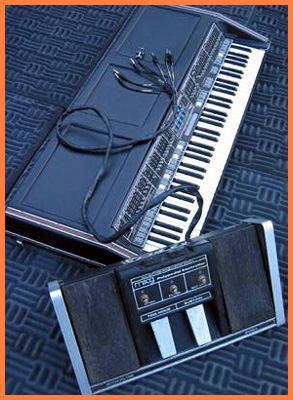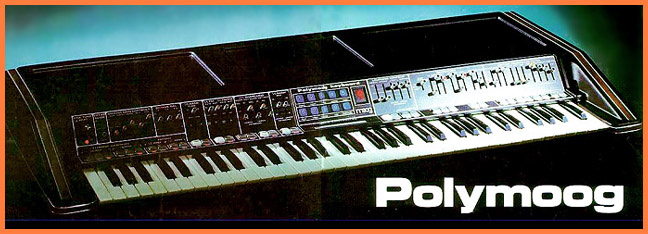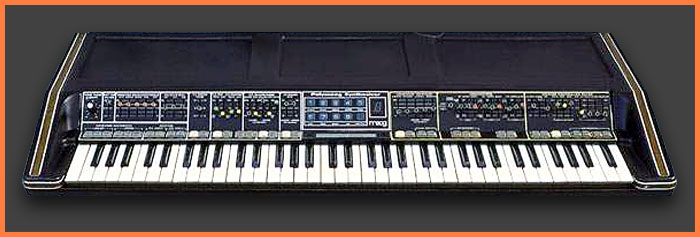|
Backlash!
|
|
|
|
|

|
|
|
Over the years, there have been many criticisms of the Polymoog. Some
claim that it was Moog's "white elephant" and was
an overweight, overpriced and unreliable relic that is best
forgotten. The problem seems to be that many of the current
Polymoog critics are keen to dismiss it without actually having
heard one! They simply look at the sound generating architecture
on paper and dismiss it as "a glorified organ".
|
|
|
|
|
|
Polymoog
US Price List: 1 Oct 1979
|
Polymoog
UK Price List: 1978
|
|
|
|
|
|
|
Polymoog
203a (including legs)
|
$ 5,295.00
|
£ 3,195.00
|
|
|
Polymoog
280a (including legs)
|
$ 3,995.00
|
£ 2,295.00
|
|
|
Polypedal
285a
|
$ 375.00
|
£ 225.00
|
|
|
Polymoog
Legs
|
$ 175.00
|
£ 100.00
|
|
|
|
|
|
|
|
US
Prices courtesy of Kevin Lightner at www.synthfool.com
|
UK
Prices lifted from an old Sound on Sound article
|
|
|
|
|

|
|
|
|
|
|
|
|
The sound architecture certainly has its limitations, but the same
can be said of all synthesizers, (including the revered Minimoog
of which I'm also a huge fan - aren't we all?) and we shouldn't
lose sight of the fact that the Polymoog had a genuine Moog
ladder filter.
|
|
|
|
|
|
|
|
|
Dave
Luce made the Polymoog with the Minimoog in mind. The original
concept was that the Polymoog would be used to accompany a
distinctive Moog lead synth such as the Minimoog. That is
why the top was designed as it was, specifically for a Minimoog
to sit snugly. It would make little sense to have the same
sound on both machines so the Polymoog sound was tailored
to produce different timbres to the monophonic lead sound
and maybe that is where "retro reviewers" have taken
exception. They may well see the word "Moog" and
expect Kraftwerk "Autobahn" like sweeps, buzzes
and whooshes, assuming that all Moog's have to sound similar
in some way. To quote Dave Luce himself… "To criticise
it for not sounding like a Minimoog is missing the point!"
As
a Polymoog owner and enthusiast, you might expect me to say
"they're all wrong you know", but lets look in detail
at these criticisms...
|
|
|
|
|
|

|
|
Was it overweight?
Of
course! At 82 Ibs (37 Kg), (nearly 6 stones) requiring two
people to lift and almost 4 feet long and 2 feet wide… by
today's standards it was a monster!
Back
in the mid 70's, to the roadies accustomed to hauling Organs
and Electric Piano's, with nightmare memories of the dreaded
modular systems of a few years previous, it was child's play.
If you ever see one taken apart, you can see it is rammed
to the gills with components, many of which would be miniaturised
to insignificant proportions today but that just wasn't possible
in 1975. By comparison, the mighty Yamaha CS-80 which appeared
two years later weighed an astonishing 220 lbs (four times
the weight of the Polymoog) but with similar dimensions.
|
|
|
|
|
Was it overpriced? In 1976 it was horrifically expensive (around $5000
compared to just under $2000 for the Minimoog). Seemingly
out of reach for most musicians, surprisingly the price list
hardly changed from 1976 to 1980 and it sold very well during
its fleeting moments of fame. Back in 1975, the Polymoog really
was every keyboard players "dream machine" and the
fact that Keith Emerson, Chic Corea, Herbie Hancock and a
host of
|
|

|
|
|
|
|
luminaries
were all being seen with one didn't hurt. For those with huge
album deals it became a popular instrument because of its
great keyboard action, the facility to edit the onboard presets
into unique sounds and it really did give the players of the
day what they wanted. To bring back the comparisons, the Yamaha
CS-80 was selling for $7000 in 1977 so it was pretty well
positioned within its price bracket...
|
|
|

|

|

|

|

|

|

|

|

|

|

|

|

|

|

|
|